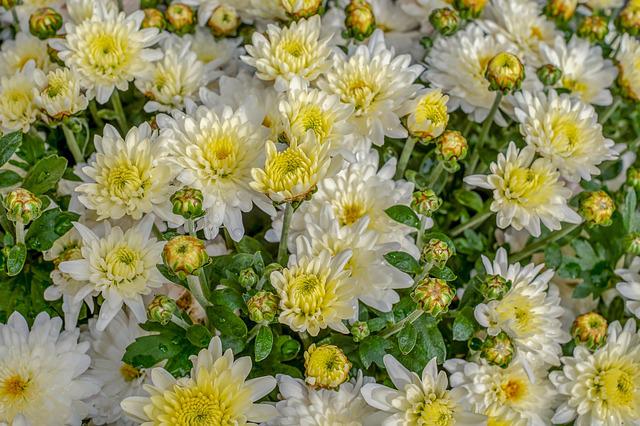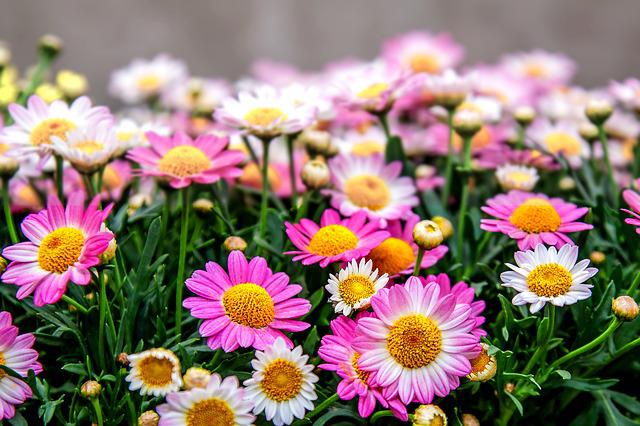When Do Chrysanthemums Bloom? Keeping Mums’ Flowers

Chrysanthemums usually start blooming in late spring or early summer and usually last until late fall – though this can also vary depending on the location. One of the most popular flowers in the world, chrysanthemums are known for their vibrant colors and long blooming season. A few factors can play into when chrysanthemums bloom, including temperature, sunlight, and watering. While weather conditions and soil fertility can also affect the blooming schedule of these flowers, most times, they will follow the typical flowering patterns outlined above.
Most garden chrysanthemums can survive in the US Department of Agriculture plant hardiness zones 5 to 9. After the summer equinox, the days gradually get shorter, which makes flowers bloom. However, some varieties may bloom in the early, middle, or late fall. Temperature and humidity can also affect when the flowers bloom; pinching back the flowering stems after early July can make them bloom later.
Table of Contents
How to Maintain Your Chrysanthemums’ Bloom
Water
Water your chrysanthemums according to their growth cycle, but don’t overdo it. Too much water can cause soil to dry out, so keep the water content around 50% during the summer.
If you are watering chrysanthemums outdoors, it is best to do so in the morning or evening when the sun doesn’t shine directly on them. Ensure that the soil is moist but not wet and that there is plenty of drainage around your plant. If you are watering chrysanthemums indoors, ensure the pot contains fresh soil and only enough water to cover the rootball barely. Watering too much or not enough will cause wilted flowers and leaf drops.

Pinching
Pinching your mum’s stems in the spring is the key to maximizing flower production. Pinch off the tip of each shoot whenever it reaches a length of five to six inches, just above the leaves and two to three inches down the stem. When the stems are another five to six inches tall, they can be pinched once more. Each pinched stem will also produce more stems. The growth cycle naturally slows down in July, so keep going with this process until then. By doing so, the plant will become fuller, have more branches, and bear a greater number of flowers.
Fertilizer
Your chrysanthemums should be fertilized in the spring and summer. Chrysanthemums flower best when fertilized with a balanced blend of organic matter and plant-based nutrients. The most important thing to remember is to ensure that the fertilizer you use is designed explicitly for chrysanthemums. There are many different brands and types of fertilizers on the market, so it is important to do your research before choosing one.
Mulching
Mulching Chrysanthemum can help reduce the amount of moisture lost from your flowers and garden, which will improve soil quality and help prevent weeds from spreading. Additionally, mulched plants are less likely to require water during dry periods, so you’ll save time and money in the long run. Attach a layer of black plastic or heavy-duty paper prefabricated mats around the base of your plants before foliage begins to grow. This will block sunlight and keep the ground cool and moist. Be sure to remove these protective covers once flowering has ended so that wind can access your flowers’ roots.
Remove Old Stems
A Chrysanthemum plant typically produces large quantities of beautiful, white flowers over the summer. However, removing old stems from your chrysanthemums before they flower will save you a lot of time and hassle in the long run.
Stems over two months old can be difficult to remove without damaging or killing the plants. Old stems often have roots that penetrate deep into the soil, so it is important to use proper techniques when removing them. Cutting away at a stem close to ground level may cause damage downstream; instead, try using a Bobcat claw hammer or digging out with a spade before pulling up any unwanted material with brute force. You might also consider hiring an experienced Removalist for this job!
Deadheading
Deadheading chrysanthemum is an essential part of the chrysanthemum plant’s care. By deadheading, you are removing the spent flowers from the stem before they have a chance to pollinate other flowers and create seed pods. This prevents unwanted plants and pollen from producing new chrysanthemums, which can interfere with your garden’s balance.
This is a necessary step to keep the plant healthy and flowering. Doing this will also decrease your maintenance costs since you won’t need to water or fertilize them as often.
Chrysanthemums are best grown in partial sunlight, but direct sun exposure can cause the flowers’ fading and discoloration. To achieve the desired coloration, it’s important that deadhead chrysanthemums at least two times per week during peak hours (between 10 am-2 pm). If you’re living in an area that receives a lot of indirect light throughout the day, you may only need to deadhead once every two weeks.

Tips and Tricks for Mums that Aren’t Flowering
If your chrysanthemum is not flowering, it could be due to various reasons, such as improper care, pest infestations, or disease. Chrysanthemums are very low maintenance and easy to care for. Don’t prune the plant until the spring. By pruning the plant, you’ll make it grow more branching stems, giving buds more places to grow. While others gently tip them, some gardeners cut them back to 2 inches (5 cm) above the ground. Early in the spring, liquid fertilizer will be beneficial for chrysanthemums. Pinching mum’s back is one of the tricks to getting flowers to grow on them. This entails using pruners to cut off the early buds. The plant will produce more stems and larger and numerous buds if the top growth is cut back to the next branching area.
Although you can pinch plants earlier, the optimal time is around July 4. Just be cautious not to pinch plants two months before their anticipated bloom because doing so will cause you to lose all the buds and result in a plant that doesn’t flower.
